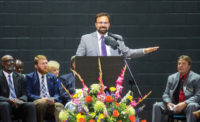For years, the U.S. Environmental Protection Agency and industrial facility owners have been wrestling over a regulation that was first included in the U.S. Clean Water Act of 1972. Section 316(b) of the CWA covers water-intake structures.
The still-pending regulations—which may become law in June, according to EPA's website—aim to minimize marine impacts of industrial plants that use water for cooling. Many facilities kill fish, crabs and other "aquatics" by sucking them into their water intakes before spitting them out like chum, says Donahue.
For Cape Canaveral and the other two plants, FPL is building water intake structures with a system of traveling screens, buckets and returns that will enable the vast majority of marine life to ride through unharmed before their discharge downstream into the river.
"This is the latest and greatest" technology for this, says Donahue.
FPL was required to have the new system operational by the time the plant came online. But it made sure existing intakes were rebuilt so the system would operate by the start of testing, adds Donahue.
Manatees are notorious for huddling around the water discharges of Florida powerplants during cold snaps. To accommodate the endangered creatures, FPL set up a system to keep the warmer water flowing on cold days—even while the plant is offline.
Scarcity of Trades
A big problem during the course of the project was the scarcity of welders and, to a lesser extent, instrument fitters, says Zachry's Power.
The shortages are industry wide, but they are worse in Florida than in many other areas, he says. And Florida has fewer projects, compared with nearby Texas and the Gulf Coast region. There, welding jobs often pay an estimated $5 to $6 more per hour.
Welders peaked at about 175 on the job. "I never could get the number of welders I needed," Power says. "Structure welders are not too hard to get, but [finding] heavy wall chrome welders was tough."
Zachry took a proactive approach to the problem by creating welders from the project's unskilled laborers through after-hour training classes at the jobsite. The program ended up graduating 17 welders. Each then earned $23 per hour as a starting wage instead of $15 per hour.
Zachry directly employed an estimated 90% of all craftworkers on the project, which numbered approximately 650 at peak.
When the Cape plant opens, Donahue, a third-generation millwright—with 18 years of powerplant construction experience with Bechtel and eight years with FPL—will head south to Port Everglades to manage the final project of the three modernizations.
The utility is still waiting for responses to its solicitation for proposals for Port Everglades. Zachry intends to be one of the competitors, says Power.
FPL expects to select a contractor by June. That's about the same time crews with D.H. Griffin Demolition Co. will begin to demolish the existing Port Everglades plant, and start the process all over again.












Post a comment to this article
Report Abusive Comment